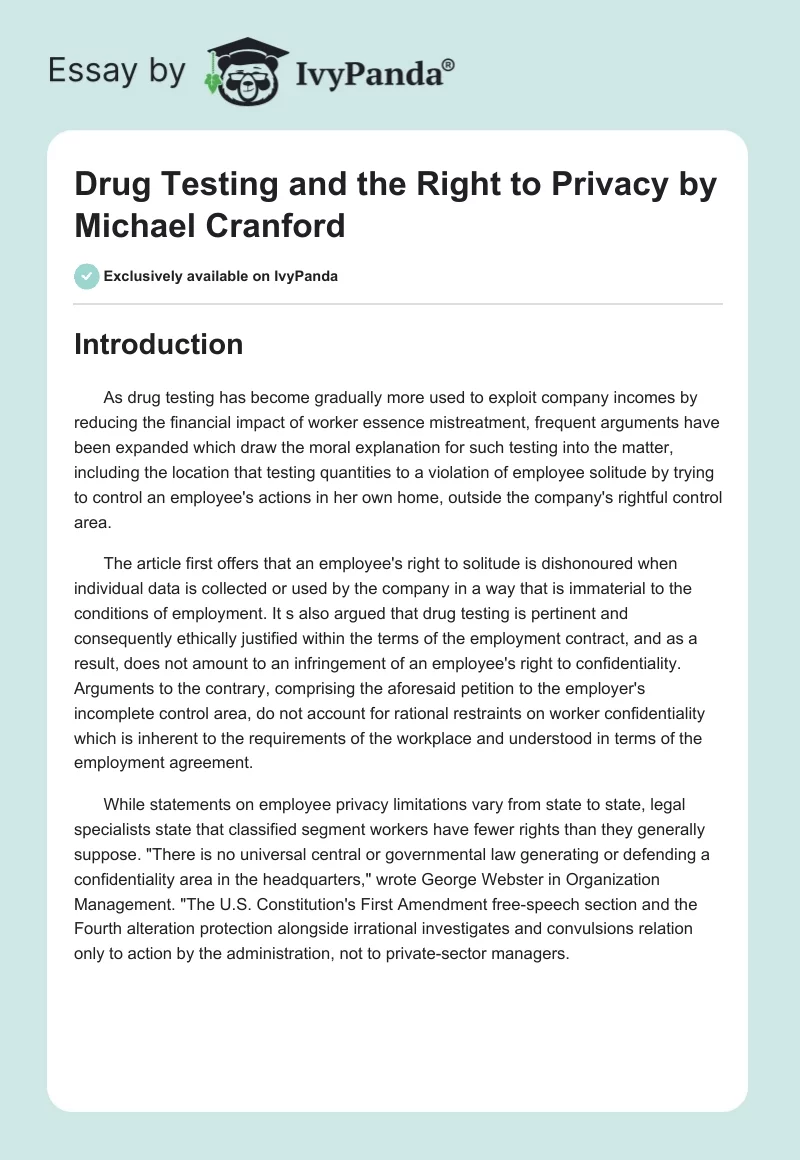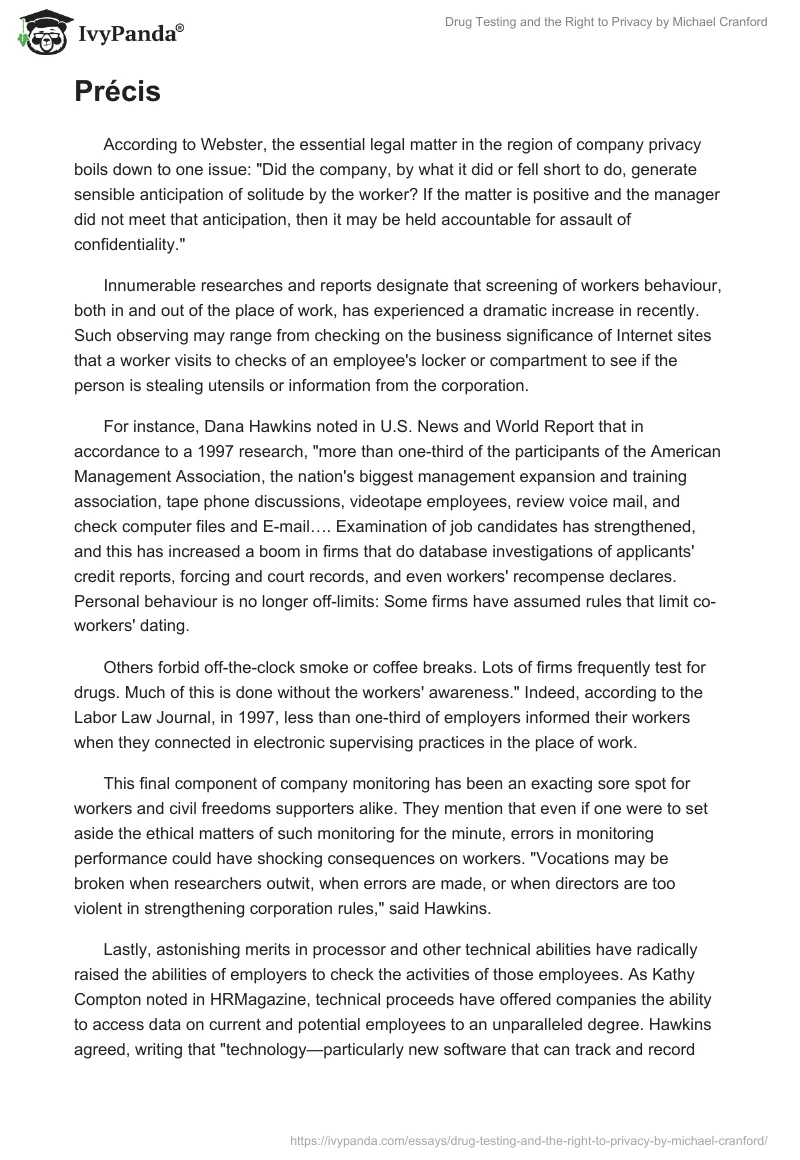Introduction
As drug testing has become gradually more used to exploit company incomes by reducing the financial impact of worker essence mistreatment, frequent arguments have been expanded which draw the moral explanation for such testing into the matter, including the location that testing quantities to a violation of employee solitude by trying to control an employee’s actions in her own home, outside the company’s rightful control area.
The article first offers that an employee’s right to solitude is dishonoured when individual data is collected or used by the company in a way that is immaterial to the conditions of employment. It s also argued that drug testing is pertinent and consequently ethically justified within the terms of the employment contract, and as a result, does not amount to an infringement of an employee’s right to confidentiality. Arguments to the contrary, comprising the aforesaid petition to the employer’s incomplete control area, do not account for rational restraints on worker confidentiality which is inherent to the requirements of the workplace and understood in terms of the employment agreement.
While statements on employee privacy limitations vary from state to state, legal specialists state that classified segment workers have fewer rights than they generally suppose. “There is no universal central or governmental law generating or defending a confidentiality area in the headquarters,” wrote George Webster in Organization Management. “The U.S. Constitution’s First Amendment free-speech section and the Fourth alteration protection alongside irrational investigates and convulsions relation only to action by the administration, not to private-sector managers.
Précis
According to Webster, the essential legal matter in the region of company privacy boils down to one issue: “Did the company, by what it did or fell short to do, generate sensible anticipation of solitude by the worker? If the matter is positive and the manager did not meet that anticipation, then it may be held accountable for assault of confidentiality.”
Innumerable researches and reports designate that screening of workers behaviour, both in and out of the place of work, has experienced a dramatic increase in recently. Such observing may range from checking on the business significance of Internet sites that a worker visits to checks of an employee’s locker or compartment to see if the person is stealing utensils or information from the corporation.
For instance, Dana Hawkins noted in U.S. News and World Report that in accordance to a 1997 research, “more than one-third of the participants of the American Management Association, the nation’s biggest management expansion and training association, tape phone discussions, videotape employees, review voice mail, and check computer files and E-mail…. Examination of job candidates has strengthened, and this has increased a boom in firms that do database investigations of applicants’ credit reports, forcing and court records, and even workers’ recompense declares. Personal behaviour is no longer off-limits: Some firms have assumed rules that limit co-workers’ dating.
Others forbid off-the-clock smoke or coffee breaks. Lots of firms frequently test for drugs. Much of this is done without the workers’ awareness.” Indeed, according to the Labor Law Journal, in 1997, less than one-third of employers informed their workers when they connected in electronic supervising practices in the place of work.
This final component of company monitoring has been an exacting sore spot for workers and civil freedoms supporters alike. They mention that even if one were to set aside the ethical matters of such monitoring for the minute, errors in monitoring performance could have shocking consequences on workers. “Vocations may be broken when researchers outwit, when errors are made, or when directors are too violent in strengthening corporation rules,” said Hawkins.
Lastly, astonishing merits in processor and other technical abilities have radically raised the abilities of employers to check the activities of those employees. As Kathy Compton noted in HRMagazine, technical proceeds have offered companies the ability to access data on current and potential employees to an unparalleled degree. Hawkins agreed, writing that “technology—particularly new software that can track and record everything workers do on their computers—is making it easier to peek over a worker’s shoulder.”
Of course, this same technology has also complicated the privacy issue for many business owners and managers because it has enabled employees to gain access to a wide variety of non-business related material, from pornography to information on civil war reenactments or other hobbies, from their office desks.
Argument sketch
Given the danger of lawsuit, the impact of worker presentation on bottom-line monetary presentation, and the wide variety of monitoring equipment obtainable, it is hardly startling that employee confidentiality has been whittled away to some quantity recently. But spectators note that many firms are trying to strike the equilibrium among self-defence and sympathy to the feelings of their employees. This is mainly true in the small business world.
Spectators note that small commerce surroundings classically feature working agreements where owners operate in close nearness to their workers. Companionships often blossom in such cases, but the probability of mounting lock individual relations with a company or employee is harshly limited if the company persists in maintaining rules that are regarded as intrusive. Surely, lots of small businesses are family-owned businesses as well, one more factor that can set hurdles employee monitoring efforts significantly. Some researchers would argue that family businesses that feel a necessity to execute monitoring strategies on family associates within the commerce are already likely to be frighteningly dysfunctional on numerous stages.
But even if companionships or family relatives are not matters for a small business owner, he or she should still advance employee privacy issues with some care. Undoubtedly, small business landlords have every right to defend themselves and their trades, and many of them come across conditions in which monitoring performs become a workable option. But some forecasters think that small business proprietors who perform active monitoring of workers run a superior risk of undercutting assurance.
After all, whereas employee observing has become a documented reality in lots of sectors of the often unfriendly “Fortune 500” world, it is sighted as a practice that is at odds with the ambience at many small business organizations. And, of course, some small businesses function in niche spheres in which the opportunity/need to connect in employee monitoring is less obvious. The activities of workers in a small outdoor landscaping compact, for instance, would perhaps be less likely to be checked than those of employees in a small market investigate the company or other firm that makes extensive use of computer technology. In addition, legal experts point out that small businesses that are found liable for excesses in this area are far more likely to be irrevocably crippled than are larger corporations with deeper pockets.
Conclusion
This article emphasizes the importance of communication in the successful application of privacy policies. To ensure that worker solitude processes and policies are understood by managers, supervisors, and employees, the message is significant. Through communication, employee privacy procedures and policies are disseminated within the employer’s organization. Communication guarantees knowledge, realization, and unswerving submission of privacy procedures and policies.
References
Cranford, Michael. “Drug Testing and the Right to Privacy.” Journal of Business Ethics. 1998.
Conlon, Kevin J. “Privacy in the Workplace.” Labor Law Journal. 1997.
Decker, Kurt H. A Manager’s Guide to Employee Privacy: Laws, Policies, and Procedures. New York: John Wiley & Sons, 1989.
Hawkins, Dana. “Who’s Watching Now? Hassled by Lawsuits, Firms Probe Workers’ Privacy.” U.S. News & World Report. 1997.
Ramsey, Robert D. “The Snoopervision Debate: Employer Interests vs. Employee Privacy.” Supervision. 1999.


